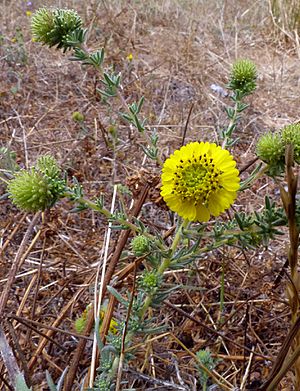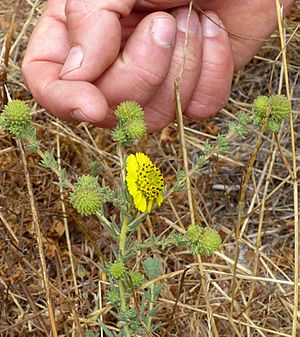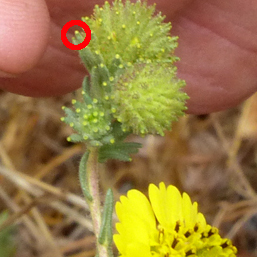Santa Cruz tarplant facts for kids
Quick facts for kids Santa Cruz tarplant |
|
|---|---|
 |
|
| The Santa Cruz tarplant is listed as threatened under the federal Endangered Species Act (ESA), and endangered under the state of California Endangered Species Act (CESA). | |
| Conservation status | |
| Scientific classification | |
| Kingdom: | |
| (unranked): | |
| (unranked): | |
| (unranked): | |
| Order: | |
| Family: | |
| Genus: | |
| Species: |
H. macradenia
|
| Binomial name | |
| Holocarpha macradenia (DC.) Greene, 1897
|
|
| Synonyms | |
|
Hemizonia macradenia DC. 1836 |
|
The Holocarpha macradenia, also known as the Santa Cruz tarplant, is a special plant that is in danger of disappearing. It is a type of plant that grows only in Northern California. People also call it the Santa Cruz tarweed or Santa Cruz sunflower.
Contents
Where Does the Santa Cruz Tarplant Live?
This plant mostly grows along the coast in Santa Cruz County and Monterey County. You can also find smaller groups of them further north in Alameda County, Contra Costa County, and Marin County. It lives from sea level up to about 110 meters (360 feet) high.
The Santa Cruz tarplant loves to grow in grassy areas called prairies, especially near the coast or in valleys. It prefers sandy clay soils. Its natural home is in the California coastal prairie ecosystem. This ecosystem might be one of the oldest stable natural areas in the world, going back about 600,000 years!
What Does the Santa Cruz Tarplant Look Like?
The Santa Cruz tarplant is an annual wildflower. This means it grows from a seed, flowers, produces seeds, and then dies all in one year. It can grow up to 50 centimeters (about 20 inches) tall, but it's often much smaller. It usually has one straight stem, but bigger plants can have branches.
Its leaves are long and thin, and they are longer near the bottom of the plant. The lower leaves have short, sharp teeth on their edges. The upper leaves have edges that curl back, making them feel bristly.
Many other plants look similar to the Santa Cruz tarplant, so it can be tricky to tell them apart. But the real Santa Cruz tarplant has special glands that look like tiny bumps. These glands help you identify it.
The plant has a strong smell that some people describe as citrusy, like tangerines, or even like a Christmas tree. This strong smell is helpful because it keeps many animals from eating the plant.
The Santa Cruz tarplant has bright yellow flowers that look like small daisys. They have black centers because of their black anthers, which look like striking black dots. It has many flowers: 8 to 16 outer "ray" flowers (the petals) and 40 to 90 central "disk" flowers (the center part). This is more than any other plant in its group, Holocarpha. The flowers grow in tight groups at the ends of branches or along the branches on very short stems.
How Does the Santa Cruz Tarplant Survive Dry Summers?
The Santa Cruz tarplant has a very long tap root. This deep root helps it find water deep in the soil, allowing it to stay alive longer into the dry season than most other coastal wildflowers.
The plant also creates seedbanks. This means it produces many seeds that might not sprout the next year. Instead, they can stay alive in the soil for several years, waiting for the right conditions to grow.
It blooms in the summer when there are fewer other plants flowering. This means there is less competition for pollinators (like bees) and more sunlight for the plant. To protect itself from the dry summer, its leaves and stems have a sticky, resin-like coating. This coating helps the plant hold onto water. Sometimes, this sticky resin can get on animals, like livestock. If it gets on their faces, dust can stick to it, making it look like they have "mascara" on!
Protecting the Santa Cruz Tarplant
By 1960, people thought the Santa Cruz tarplant was almost gone. Because of this, it was listed as an endangered species in California and a threatened species by the U.S. government.
Today, you can find groups of these plants in several places. In the city of Santa Cruz, they grow in areas like the Arana Gulch greenbelt, near De La Veaga Golf Course, Twin Lakes, and along Graham Hill Road. In Watsonville, they are found in grasslands near Harkins Slough, on a small coastal prairie called Tarplant Hill, at Spring Hills Golf Course, and on the Watsonville Airport property. They also grow in Elkhorn Slough at the Elkhorn Slough Foundation's Porter Ranch in Monterey County.
In the 1980s, more groups of these plants were found in the San Francisco Bay Area. For example, a group was found in Pinole. To allow a new shopping center to be built, some seeds from that group were moved to a new location. Other seeds were moved to a regional park, but most of those plants did not survive.
At the Arana Gulch area in Santa Cruz, the Santa Cruz tarplant has struggled to survive. This is mainly because the area isn't managed well, its habitat is broken up, and other non-native plants compete with it. However, in 2007, people started trying to actively restore the plants at Tarplant Hill in Watsonville, with help from the U.S. Fish and Wildlife Service.
Areas Protected as Critical Habitat
In 2002, the U.S. Fish and Wildlife Service officially named certain areas as "Critical Habitat" for the Santa Cruz tarplant. This means these places are very important for the plant's survival and need special protection.
These protected areas include:
- UNIT A - Mezue (in Contra Costa County)
- UNIT B - Graham Hill
- UNIT C - De Laveaga
- UNIT D - Arana Gulch
- UNIT E - Twin Lakes
- UNIT F - Rodeo Gulch
- UNIT G - Soquel
- UNIT H - Porter Gulch
- UNIT I - Watsonville
- UNIT J - Casserly
- UNIT K - Elkhorn
In total, about 1,175 hectares (2,902 acres) were set aside as Critical Habitat in 2002.
What Are People Doing to Help the Plants Grow?
Many groups are working to help the Santa Cruz tarplant populations. For example, in the Arana Gulch area, the City of Santa Cruz created a special group of experts to manage the land. This group included scientists, biologists, and city staff. They met regularly to plan how to help the plants.
At Twin Lakes State Park, people tried different ways to help the plants between 1998 and 2003. They mowed the area, removed dead plants, and even planted some young tarplants that were grown in a nursery. The nursery-grown plants were stronger and produced many more seeds than the wild ones. They also tried growing plants from seeds they had collected in previous years.
How Are Plant Numbers Changing?
Scientists keep track of the number of Santa Cruz tarplants in different areas to see if their efforts to help the plants are working. They count or estimate how many plants are in a certain area each year.
At Arana Gulch, for example, in 1986, someone estimated there were 100,000 plants. But by 2006, the plants had disappeared from most of that area, and only 348 plants were left in one section. In some years, like 2015 and 2017, no plants were found at all. Then, in 2018, 267 plants grew, but in 2019, only 47 were counted. In 2020, only one wild plant was found, though some planted seedlings survived. This area has a lot of weed grasses, which compete with the tarplant.
In comparison, at a private property called Byers Lane, about five miles south, the land was mostly covered in weeds. But in just ten years, people were able to restore it so that 95% of the plants growing there were native ones. This shows that with the right methods, it is possible to help the Santa Cruz tarplant.
The "Tarplant Hill" area in Watsonville has also seen big changes in plant numbers. In 1989, an amazing 400,000 plants were estimated there! But then, in some years like 1993, 1994, and 2003, only a single plant was found. More recently, numbers have gone up and down, with 189 plants counted in 2009.
At Twin Lakes, the number of naturally growing plants was very low, with only 16 in 1999 and dropping to 5 plants in 2003. These numbers show how much work is needed to protect this special plant.




